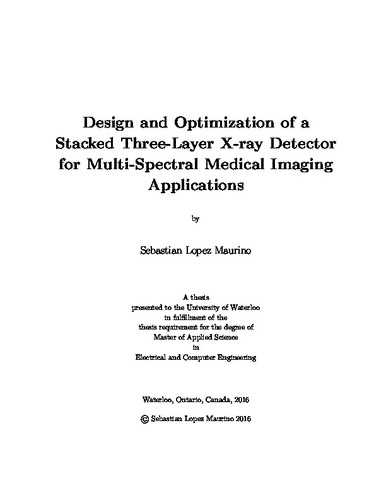| dc.contributor.author | Lopez Maurino, Sebastian | |
| dc.date.accessioned | 2016-06-16 17:45:48 (GMT) | |
| dc.date.available | 2016-06-16 17:45:48 (GMT) | |
| dc.date.issued | 2016-06-16 | |
| dc.date.submitted | 2016-06-13 | |
| dc.identifier.uri | http://hdl.handle.net/10012/10551 | |
| dc.description.abstract | Dual-Energy (DE) imaging is a powerful technique in x-ray imaging that increases the ability to detect specific materials in a cluttered background, and is used to more accurately visualize anatomical features and diagnose abnormalities. Single-shot imaging has arisen as one of the dominant techniques used to obtain DE images, but has the intrinsic drawback of a loss of x-ray photons in a metal mid-filter.
I propose a new design of a stacked three-layer x-ray detector for DE single-shot imaging that addresses this fundamental drawback. Each layer consists of its own scintillator of individual thickness and an underlying thin-film-transistor-based flat-panel. Three images are obtained simultaneously in the detector during the same x-ray exposure, and thus the imaging system is immune to motion artifacts. The detector operation is two-fold: a conventional radiography image can be obtained by combining all three layers' images, while a DE subtraction image can be captured from the front and back layers, where the middle layer acts as a filter that helps achieve spectral separation.
Two sample imaging tasks that can particularly benefit from this new detector design are selected. These are iodinated vessel visualization in coronary angiography and calcified nodule detection in pulmonary radiology. I proceed to optimize the detector parameters and imaging system configuration to best fit these two tasks by obtaining the best possible contrast to noise ratio per root entrance exposure. To achieve this, I develop an analytical model by adapting well-established theoretical foundations to fit this new detector design.
These results are compared to a conventional DE temporal subtraction detector and a typical single-shot DE subtraction detector with a metal mid-filter, both of which underwent a similar analytical optimization process. The findings are then validated using advanced Monte Carlo simulations for all optimized detector configurations.
The analytical and simulation results indicate that the proposed detector performs comparably as a DE imager to established single-shot detectors. It is therefore clear that this new design is an improvement on the state-of-the-art since it provides an additional feature at no performance cost.
Given the performance expected from these initial results and the recent decrease in price for digital x-ray detectors, the simplicity of the three-layer stacked imager approach appears promising to usher in a new generation of multi-spectral digital x-ray imaging. | en |
| dc.language.iso | en | en |
| dc.publisher | University of Waterloo | en |
| dc.subject | X-ray | en |
| dc.subject | Detector | en |
| dc.subject | Dual Energy | en |
| dc.subject | Multilayer | en |
| dc.subject | Multi Spectral | en |
| dc.subject | Flat-Panel Detector | en |
| dc.subject | Angiography | en |
| dc.subject | Radiography | en |
| dc.title | Design and Optimization of a Stacked Three-Layer X-ray Detector for Multi-Spectral Medical Imaging Applications | en |
| dc.type | Master Thesis | en |
| dc.pending | false | |
| uws-etd.degree.department | Electrical and Computer Engineering | en |
| uws-etd.degree.discipline | Electrical and Computer Engineering | en |
| uws-etd.degree.grantor | University of Waterloo | en |
| uws-etd.degree | Master of Applied Science | en |
| uws.contributor.advisor | Karim, Karim | |
| uws.contributor.affiliation1 | Faculty of Engineering | en |
| uws.published.city | Waterloo | en |
| uws.published.country | Canada | en |
| uws.published.province | Ontario | en |
| uws.typeOfResource | Text | en |
| uws.peerReviewStatus | Unreviewed | en |
| uws.scholarLevel | Graduate | en |

